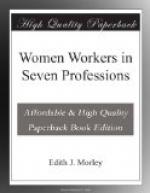V. WOMEN IN THE CIVIL SERVICE
I. The higher grades:
Present position and
prospects for the future. By a Woman
Civil
Servant
II. The lower grades and the present
position.
By Another Woman Civil Servant
VI. Women clerks and secretaries. By (Mrs)
ELSPETH Keith Robertson
Scott
VII. Acting as A profession for women. By Lena Ashwell
APPENDIX I. SCHEME OF WORK OF THE FABIAN WOMEN’S GROUP
Appendix ii. Latest census
returns of women workers in
the seven
professions considered in this
book
FOREWORDS
ON BEHALF OF THE STUDIES COMMITTEE OF THE FABIAN WOMEN’S GROUP
The present economic position of women bristles with anomalies. It is the outcome of long ages of semi-serfdom, when women toiled continuously to produce wealth, which, if they were married, they could enjoy only at the good pleasure of their lords,—ages when the work of most women was conditioned and subordinated by male dominance. Yet in those days the working housewife commanded the consideration always conceded to a bread-winner—even when dependent. In modern times women’s economic position has been undermined by the helpless dependence engendered amongst the well-to-do by “parasitism” resulting from nineteenth-century luxury—to quote the striking word of Olive Schreiner. Similarly, dependence has been forced upon large sections of women-folk amongst the manual workers by the loss of their hold upon land and by the decay of home industries. Now a new force is at work: the revolt of the modern woman against parasitism and dependence in all their forms; her demand for freedom to work and to choose her sphere of work, as well as for the right to dispose of what she gains.
Six years ago some women of the Fabian Society, deeply stirred by the tremendous social import of this movement, banded themselves together to unravel the tangled skein of women’s economic subjection and to discover how its knots were tied. The first step was to get women to speak out, to analyse their own difficulties and hindrances as matters boldly to be faced. Whatever the truth may turn out to be with regard to natural and inevitable differences of faculty between men and women, it is at least certain that difference of sex, like any other persistent condition of individual existence, implies some difference of outlook. The woman’s own standpoint—that is the first essential in understanding her position, economic or other: the trouble is that she has but recently begun to realise that she inevitably has a standpoint, which is not that of her husband, or her brother, or of the men with whom she works, or even that which these persons imagine must naturally be hers. Her point of view is her own, and it is essential to social progress that she shall both recognise this fact and make it understood.




